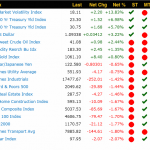The bears had an opportunity to start correcting the uptrend that started at 2000 on June 27 which was, by the way, the two-day 113-point bottoming action of a 20-wk cycle. But seasonality and other causes kept this 20-wk cycle from fully extending and made it bottom with the shortest span since 12/14.
Furthermore, the bulls rubbed salt in the wound by sending SPX soaring nearly seventy points in four trading days. To say that this seems a little excessive at this stage of the advance, is probably an understatement. Each day, the market had a gap opening which remained unfilled. But the most interesting part of this market activity is that each day the A/Ds (which opened with a 1200 to 1500 positive differential) immediately started to retrace the majority of that advance in the first hour of trading — once to neutral and once to slightly minus– before recovering partially for the rest of the day. I believe that this can only mean that smart money has been selling at each opening and, although it is unlikely that the index is making a climactic top in the beginning stages of an important cycle, it indicates that a correction will take place before prices can progress much higher.
What was thought to have been a distribution pattern turned out to be a re-accumulation phase which has given us a pretty good idea of how far this move will carry, and the first four days have already used up a good portion of that count. It also seems logical that the current wave pattern cannot extend forever without an overdue correction of appropriate degree. So, one should, at a minimum, be a little suspicious of all this exuberance. Caveat emptor.
Chart Analysis (These charts and subsequent ones courtesy of QCharts)
SPX daily chart
The chart shows how the market has begun to move exponentially since the low of the 40-wk cycle (dashed red line), and how the action of the SPX over that past four days has taken it to the very top channel line of the large channel which encompasses the price trend since the 1810 low of 02/11/16 –which was also the 7-yr cycle low. Perhaps it was the passage of the tax bill in conjunction with seasonality which truncated the size of the decline normally associated with the 20-week cycle, as well as its span. The pattern on the chart is even smaller than that caused by the bottoming of the 80-day cycle about six weeks earlier.













Leave A Comment